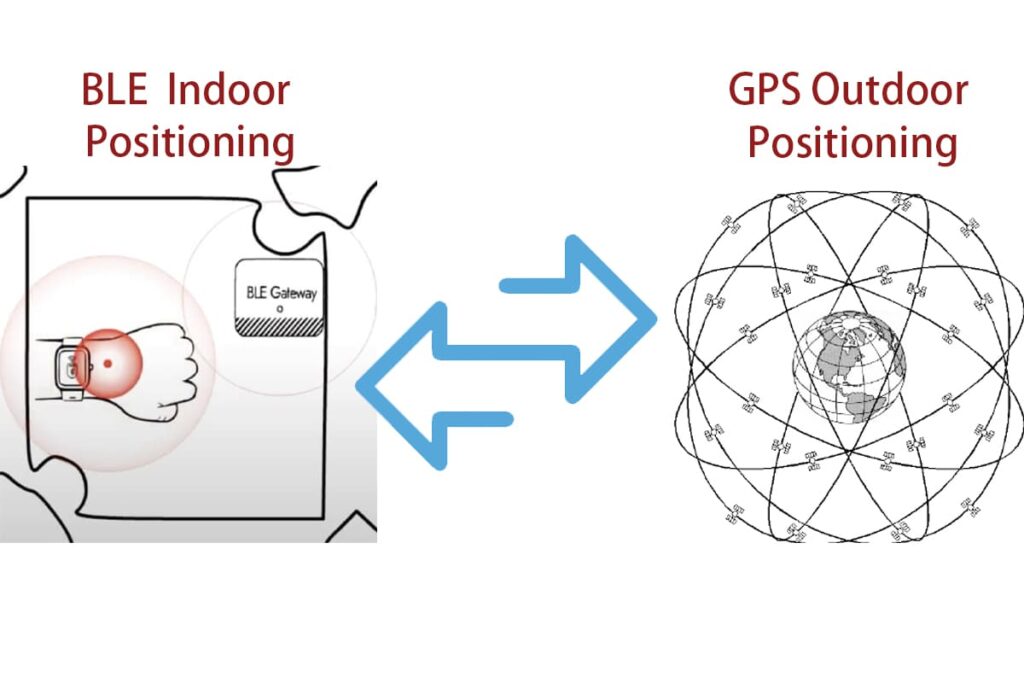BLE and GPS Positioning Switching in IoT Smart Wearables

Smart wearables are revolutionizing the way we interact with our environment and are becoming an integral part of the Internet of Things (IoT) ecosystem. A critical feature of these devices is their ability to provide accurate location tracking both indoors and outdoors. This is achieved through the intelligent switching between Bluetooth Low Energy (BLE) positioning for indoor environments and Global Positioning System (GPS) for outdoor navigation. Below we explain the advanced mechanisms that govern this switching process, ensuring seamless user experience.
Table of Contents
How BLE and GPS Positioning Work
BLE Positioning:
BLE beacons are small, Bluetooth-enabled transmitters that send out signals which can be detected by smart wearables. They are particularly useful indoors where GPS signals can be obstructed. These beacons have a unique identifier that allows the device to recognize the signal and determine the user’s location with respect to the beacon.
In the labyrinth of steel and concrete, where GPS signals falter, iSmarch’s devices shine, thanks to Bluetooth Low Energy (BLE) beacons. These compact, potent transmitters broadcast signals that our wearables interpret with ease, ensuring that each worker’s location is pinpointed with exactitude, enhancing safety protocols within the indoor confines of a construction site.
GPS Positioning:
GPS positioning, on the other hand, relies on satellites orbiting the Earth. By triangulating signals from at least four different satellites, a GPS-enabled device can pinpoint its exact location on the globe. This method is most effective in outdoor settings with a clear view of the sky.
Transitioning outside, iSmarch wearables effortlessly switch to the Global Positioning System (GPS), which locks onto satellite signals, offering a comprehensive view of workers spread across vast construction territories. This seamless shift ensures that no matter the location, iSmarch devices maintain an accurate, real-time beacon on each individual.
The Switching Algorithm
The smart wearable is designed to automatically switch between BLE and GPS positioning depending on signal availability and strength. The default configuration initiates with BLE scanning active upon device power-up.

iSmarch’s smart helmets and watches come alive at the flick of a switch, immediately scanning for BLE beacons with a default positioning check every two seconds. This vigilant scanning assesses the consistency and strength of BLE signals within three distinct periods, activating the ‘switch factor‘ — a proprietary algorithm that determines whether BLE or GPS is the optimal navigation method at any given moment.
Initial BLE Scanning:
- Upon activation, the wearable begins scanning for BLE beacons at a default frequency of every 2 seconds.
- The device continues to scan for a set number of periods (typically three) to assess the consistency of available BLE signals.
Evaluating BLE Signals:
- During each scanning period, the device records the number of beacons detected and their signal strength, measured by RSSI (Received Signal Strength Indicator).
- A switch factor ‘y’ is employed, which increases each time a beacon’s RSSI falls below the “normal switch” RSSI threshold, indicating a weaker BLE signal.
Switching Logic:
- If the switch factor ‘y’ equals or exceeds a pre-defined value (usually 3) within the most recent scanning periods, BLE positioning is deemed reliable, and the device continues to use it.
- Should the switch factor ‘y’ not meet the required threshold, the device shifts to GPS positioning, implying that the user may have moved outdoors.
Immediate Switching:
- An “immediate switch” threshold is set for situations where a rapid transition is needed.
- If the RSSI of any beacon drops below this immediate switch threshold, the wearable instantly changes to BLE positioning mode and disables GPS to conserve power.
When BLE Reigns Supreme:
- If the ‘switch factor’ detects a stable BLE environment, the device maintains its reliance on the indoor system. Only when this factor dips below our rigorous standards does the device hand over the reins to the robust GPS system, an indicator that the user has stepped into the open expanse of the outdoors.
GPS Takes the Lead:
- Our smart wearables’ GPS mode activates when the BLE’s beacon falls silent, guaranteeing continuous location tracking under the open sky. This duality not only offers peace of mind but also significantly conserves battery life, an essential feature in the demanding environment of construction work.
Dynamic Rolling Scans:
- The system operates on a rolling scan logic, where data from the oldest scan period is discarded as a new one begins.
- This ensures that the switching decision is based on the most recent and relevant signal strength data.
Implementing the Algorithm in IoT Devices
Incorporating this BLE-GPS switching algorithm into IoT smart wearables involves configuring the device’s firmware to:
- Constantly scan for BLE beacons.
- Evaluate RSSI readings against predetermined thresholds.
- Implement a switch factor to track signal quality over time.
- Manage power by turning off GPS when BLE is in use.
Advantages of BLE-GPS Switching
- Enhanced Accuracy: Provides users with precise location tracking indoors and outdoors.
- Power Efficiency: Optimizes battery usage by selecting the most power-efficient positioning method.
- Seamless Experience: Users can move between environments without manual switching or loss of service.
Conclusion
- The integration of BLE and GPS for positioning in IoT smart wearables exemplifies the synergy between different technologies to create a seamless user experience. As IoT devices continue to evolve, these intelligent systems ensure that we remain connected and informed, no matter where we are. Whether navigating through a busy mall or exploring the great outdoors, your smart wearable has you covered.
Technical Insights: BLE-GPS Positioning in Smart Wearables by iSmarch
- In the fast-evolving landscape of the construction industry, iSmarch stands at the forefront, offering state-of-the-art IoT smart wearables designed to elevate worker safety and productivity to new heights. Our sophisticated line of smartwatches and smart helmets is engineered to navigate the intricate dance between indoor precision and outdoor breadth with unparalleled accuracy. Here, we dive into the inner workings of iSmarch’s trailblazing BLE and GPS positioning technology, a cornerstone feature that assures your workforce is always within the safety net of our vigilant systems.
Contact us
Ready to embrace the future with cutting-edge location technology? Join the iSmarch revolution and transform your industry with our BLE-GPS positioning solutions. Contact us today to learn more about integrating our smart wearable technology into your operations and embark on a journey towards unparalleled efficiency and safety.
